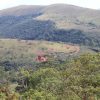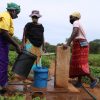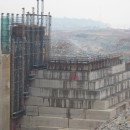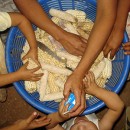Languages
Thursday, April 18, 2024
News and Views from the Global South
Water & Sanitation

Cuban Farmers Fight Land Degradation with Sustainable Management
Thorny bushes and barren soil made it look like a bad bet, but Cuban farmer José Antonio Sosa ignored other people’s objections about the land and gave life to what is now the thriving La Villa farm on the outskirts of Havana.
Caring for Water Where Mining Leads to Wealth and Tragedies in Brazil
The southeastern Brazilian state of Minas Gerais owes its name to the main economic activity throughout its history: mining – of gold since the 17th century and later iron ore, which took on an industrial scale with massive exports in the 20th century.
Floods Drive Urban Solutions in Brazilian Metropolis
"We do everything through parties, we don't want power, we don't want to take over the role of the State, but we don't just protest and complain," said Itamar de Paula Santos, a member of the United Community Council for Ribeiro de Abreu (Comupra), in this southeastern Brazilian city.
The Sun Illuminates the Nights of Rural Families in El Salvador
After working on the family farm, Carlos Salama comes home and plugs his cell phone into a socket via a solar-powered electrical system, a rarity in this rural village in southern El Salvador.
Poor Water Distribution Infrastructure Gives Jamaica a ‘Water Scarce’ Label
It will take billions of dollars and many years to fix a growing problem that has placed Jamaica into the unlikely bracket of being among the world's most water-scarce countries due to the unavailability of potable water.
Drugged Water: A New Global Pandemic Hiding in Plain Sight?
People around the world are unknowingly being exposed to water laced with antibiotics, which could spark the rise of drug-resistant pathogens and potentially fuel another global pandemic, warns a new report.
Worrying Insights from UN’s First-Ever Assessment of Water Security in Africa
When it comes to water security – a reliable, good supply of safe water – just 29 African countries have made some progress over the past three to five years. Twenty-five have made none.
Indian Agriculture Towards 2030
India began its journey as an independent nation in 1947 with fresh memory of the Bengal Famine of 1943 which claimed 1.5 to 3 million lives. Against this backdrop, the First Five Year Plan (1951-56) prioritized agriculture which, however, shifted to heavily industrialization in the second Plan.
Desalination Plants, Solution and Environmental Challenge for Chile
The Pacific Ocean could quench the thirst caused by 10 years of drought in Chile, but the operation of desalination plants of various sizes has a long way to go to become sustainable and to serve society as a whole rather than just corporations.
Water & Sanitation, a Better Future for Girls & our Planet
At the World Water Forum this week (March 21-26), the international community will raise awareness of the 2 billion people worldwide who lack access to clean water and sanitation. Among them are millions of women and girls, who walk hundreds of miles each year to find water for their families and are blocked from education and economic empowerment also due to poor sanitation services.
Water & Sanitation Crisis Escalates as Yemenis Mark World Water Day
As Yemen enters its 8th year of an escalating conflict, 21.7 million of my fellow Yemenis are forced to rely on humanitarian assistance to survive. The conflict has left a trail of devastation in its wake – the country is in economic freefall, and families face intensified violence, hunger, and disease. As we also mark another World Water Day on March 22, within Women’s History Month, it is a time to reflect on the immense water and sanitation crisis that continues to take countless lives – and how it impacts women and girls so acutely. The destruction of the country’s health and water infrastructure has left Yemen acutely vulnerable to multiple epidemics including malaria, diphtheria, dengue, cholera, and COVID-19.
Groundwater at the Heart of the Water Security Equation
Groundwater is invisible and yet its impact is visible everywhere – this infinite resource provides almost half of all drinking water worldwide. About 40% of water for irrigated agriculture and about 1/3 of water required for industry is from groundwater resources. Despite these impressive facts, groundwater remains invisible and less prominent compared to surface water.
Cyclone Ana Floods Choke Malawi’s Water and Sanitation Goals
On the night of January 24, 2022, as Cyclone Ana-triggered rains incessantly rattled on the rusty roof of her house, amid intervals of gusty winds, a thud woke up Josephine Kumwanje from her sleep.
Call for Increased Global Efforts to Ease Africa’s Climate-Induced Water Crisis
When years ago warnings were sounded that future wars would be fought not over oil but water, the predictions were dismissed as alarmist.
Spate of Water Projects in Mexico Ignore Impacts
The Mexican government is prioritizing the construction and modernization of mega water projects, without considering their impacts and long-term viability, according to a number of experts and activists.
Damaged Natural Infrastructure Exacerbates Urban Flooding in Brazil
People living in Jardim Pantanal, a low-income neighborhood on the east side of the Brazilian megalopolis of São Paulo, suffer floods every southern hemisphere summer. Many residents remember the three months their streets and homes were under water in late 2009 and early 2010.
Clean Water, Decent Toilets, Hygiene Challenge for Southern African Community
The toilets in the maternity wing of Namatapa Health Centre in the populous Bangwe Township in Blantyre, Malawi’s commercial city, fell into disrepair a few years ago. So, pregnant women who come to deliver their babies and their guardians use two pit latrines.
Too Harmful: The March of Salt and Plastics on World Soils
There are more under-reported consequences of human activities unmatching the rhythm of Mother Nature. Such is the case, among many others, of the growing salinisation and ‘plastification’ of the world's soils.
Why Does Yangtze River Have its Own Protection Law?
The new Yangtze River Protection Law (YRPL), which came into effect on March 1, 2021, is China’s first legislation on a specific river basin. The Yangtze River is China’s longest and largest river system, stretching over 6,300 kilometres and has over 700 tributaries. With a drainage basin covering more than 1.8 million square kilometres, approximately one-fifth of China’s total land area, the river basin is home to over 40% of the country’s population.
Severe Water Stress, Absolute Scarcity for 2 to 4 Billion Humans by 2025
Now it comes to the scary water crises, as it is estimated that, globally, over two billion people live in countries that experience high water stress.
Rural Women in Peru Seed Water Today to Harvest It Tomorrow
"When I was a little girl we didn't suffer from water shortages like we do now. Today we are experiencing more droughts, our water sources are drying up and we cannot sit idly by," Kely Quispe, a small farmer from the community of Huasao, located half an hour from Cuzco, the capital of Peru's ancient Inca empire, told IPS.« Previous Page — Next Page »












